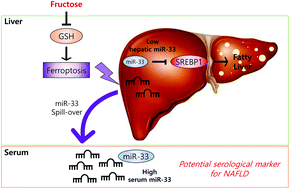The role of microRNA-33 as a key regulator in hepatic lipogenesis signaling and a potential serological biomarker for NAFLD with excessive dietary fructose consumption in C57BL/6N mice†
Abstract
Limited studies reported mechanisms by which microRNAs (miRNA) are interlinked in the etiology of fructose-induced non-alcoholic fatty liver disease (NAFLD). Here, we aimed to investigate the significance of miRNAs in fructose-induced NAFLD pathogenesis through unbiased approaches. In experiment I, C57BL/6N mice were fed either water or 34% fructose for six weeks ad libitum. In experiment II, time course effects of fructose intervention were monitored using the same conditions; mice were killed at the baseline, fourth, and sixth weeks. Bioinformatic analyses for hepatic proteomics revealed that SREBP1 is the most significant upstream regulator influenced by fructose; miR-33-5p (miR-33) was identified as the key miRNA responsible for SREBP1 regulation upon fructose intake, which was validated by in vitro transfection assay. In experiment II, we confirmed that the longer mice consumed fructose, the more severe liver injury markers (e.g., serum AST) appeared. Moreover, hepatic Srebp1 mRNA expression was increased depending upon the duration of fructose consumption. Hepatic miR-33 was time-dependently decreased by fructose while serum miR-33 expression was increased; these observations indicated that miR-33 from the liver might be released upon cell damage. Finally we observed that fructose-induced ferroptosis might be a cause of liver toxicity, resulting from oxidative damage. Collectively, our findings suggest that fructose-induced oxidative damage induces ferroptosis, and miR-33 could be used as a serological biomarker of fructose-induced NAFLD.

- This article is part of the themed collection: Food & Function Recent HOT articles


 Please wait while we load your content...
Please wait while we load your content...